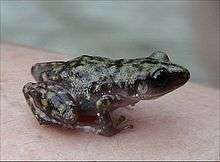Eleutherodactylus
| Eleutherodactylus | |
|---|---|
 | |
| Eleutherodactylus mimus | |
| Scientific classification | |
| Kingdom: | Animalia |
| Phylum: | Chordata |
| Class: | Lissamphibia |
| Order: | Anura |
| Family: | Eleutherodactylidae |
| Subfamily: | Eleutherodactylinae |
| Genus: | Eleutherodactylus Duméril and Bibron, 1841 |
| Species | |
|
Many, see text. | |

Eleutherodactylus is a genus of frogs in the family Eleutherodactylidae.[1] Many of the 185 species of the genus are commonly known as "rain frogs" or "robber frogs", due to their sharp, high-pitched, insect-like calls.[2]
The best-known species is the common coquí (E. coqui), which is both a national symbol of Puerto Rico and a notorious invasive species in Hawaii. Two Eleutherodactylus species, E. limbatus and E. iberia, are among the smallest known frogs, measuring only 8.5 mm in length[3] (only slightly larger than Paedophryne amauensis, which measures around 7.7 mm).[4]
Etymology
The name "Eleutherodactylus" is derived from the Greek words for ‘free-toed’, composed of the Ancient Greek eleutheros (ἐλεύθερος, ‘free, unbound’) and dactylos (δάκτυλος, ‘finger, toe’).[5] Most species are small, slender, and cryptically colored, with three to five free toes. A few, such as the web-footed coquí (E. karlschmidti) of Puerto Rico, do have completely webbed feet.
Distribution and habitat
Species of Eleutherodactylus are found throughout the Neotropics, including the Southern United States, Mexico, Central America, and the Caribbean. Additionally, the common coquí (E. coqui) has been introduced to several islands in the Hawaiian archipelago, as well as elsewhere in the Pacific.[6]
They can be terrestrial, arboreal, or aquatic, typically living in forests or riparian areas, and feeding primarily upon arthropods. Many Eleutherodactylus species have highly restricted ranges and are found on only one island or in one or a few localities. Even some of these restricted species can occur at very high densities.
Reproduction and development
All species of Eleutherodactylus are characterized by direct development, in which eggs hatch directly into small frogs, completely bypassing the tadpole stage. This adaptation may be largely responsible for their ecological and evolutionary success. Most species are characterized by parental behaviors, such as egg-guarding by either the male or female parent. In some cases, even young froglets are attended by parents. Another extinct Puerto Rican species, the golden coquí (E. jasperi), gave birth to live young. Many species (for example, Cook's robber frog, E. cooki), also of Puerto Rico, exhibit sexual dimorphism in size and color.
Phylogenetics
The basis of forming this genus has been morphological, but sequence comparisons of protein-encoding DNA, mitochondrial DNA, and ribosomal RNA have shown geographic range is a much more consistent predictor of cladistics for this group of frogs. The climbing habits of many species have evolved independently. All true members of the genus have been clustered into subgenera, but many less-related species require more genetic data before they are to be officially classified elsewhere. The theory that the eleutherodactyline colonization of Central America and the Caribbean from their origins in South America occurred during the Cretaceous has fallen out of favor. The fossil record, combined with molecular clock analyses, indicate the subgenera were probably founded by small groups of individuals by flotsam dispersal during the Eocene or Oligocene epochs. Land bridges would have been limited to facilitating dispersal between West Indian islands, however, the Oligocene division of Hispaniola and Cuba resulted in further speciation. The distribution of the subgenus Syrrhopus is most likely due to a secondary dispersal to Central America from the Greater Antilles during the Miocene. The formation of the Panama Isthmus during the Pliocene has caused some intercontinental distribution among the clades, although only 20 "South American frogs" have ever made it northwards after the original colonization.[7] Sensu stricto, however, it should exclude clades with distributions south of the Panama Canal.[7]
Species
West Indian (subgenus Eleutherodactylus)
|
|
|
West Indian (subgenus Euhyas)
|
|
|
Hispaniolan (subgenus Pelorius)
|
|
|
North/Central American and Cuban (subgenus Syrrhopus)
|
|
|
Central American clade (genus/subgenus Craugastor)
|
|
|
References
- ↑ Hedges, S. B., W. E. Duellman, and M. P. Heinicke . 2008. New World direct-developing frogs (Anura: Terrarana): molecular phylogeny, classification, biogeography, and conservation. Zootaxa 1737: 1-182.
- ↑ "Amphibian Species of the World". Retrieved 2011-11-23.
- ↑ The Center for Reptile and Amphibian Research: Interesting Facts About Amphibians
- ↑ Rittmeyer, E. N.; Allison, A.; Gründler, M. C.; Thompson, D. K.; Austin, C. C. (2012). "Ecological guild evolution and the discovery of the world's smallest vertebrate". PLoS ONE. 7 (1): e29797. doi:10.1371/journal.pone.0029797. PMC 3256195
 . PMID 22253785.
. PMID 22253785. - ↑ Dodd, C. Kenneth (2013). Frogs of the United States and Canada. 1. The Johns Hopkins University Press. p. 20. ISBN 978-1-4214-0633-6.
- ↑ [http://www.issg.org/database/species/ecology.asp?si=105&fr=1&sts> "Eleutherodactylus coqui (amphibian) at the Global Invasive Species Database"]. Retrieved 2007-06-06.
- 1 2 Heinicke, M.P., W.E. Duellman & S.B. Hedges (2007). "Major Caribbean and Central American frog faunas originated by ancient oceanic dispersal". Proc. Natl. Acad. Sci. 104 (24): 10092–7. doi:10.1073/pnas.0611051104. PMC 1891260
 . PMID 17548823.
. PMID 17548823.